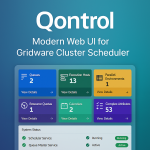This article explains how the three binding options -bsort, -bstart, and -bstop control where and in which order jobs are bound to CPUs in Gridware Cluster Scheduler. Together, they define the scheduler’s fill-up pattern — how hardware resources are used, balanced, or reused across sockets, cores, and NUMA nodes. Understanding these options is essential for…
Category: HPC
Gridware Cluster Scheduler and Open Cluster Scheduler
Qontrol – A Modern Web UI for Gridware Cluster Scheduler
With our latest announcement at HPC-Gridware, we’re introducing Qontrol — a completely new, web-based user interface for Gridware Cluster Scheduler.
Understanding Binding in Gridware Cluster Scheduler
Modern compute nodes have grown increasingly complex — featuring heterogeneous cores, multi-level caches, and intricate NUMA topologies. In the previous post, Compute Nodes with Heterogeneous Topology in Gridware Cluster Scheduler, we looked at how these topologies are detected and represented in Gridware Cluster Scheduler. This post explores binding — how the scheduler decides where exactly…
Compute Nodes with Heterogeneous Topology in Gridware Cluster Scheduler
As CPUs evolve toward hybrid designs with mixed core types and increasingly complex memory hierarchies, HPC schedulers must also evolve.This post explains how Gridware Cluster Scheduler 9.1.0 meets that challenge—bringing detailed, topology-aware resource scheduling to modern heterogeneous compute nodes.
Open Cluster Scheduler and Gridware Cluster Scheduler v9.0.8 are Available
OCS and GCS v9.0.8 are now available. As usual, the packages can be downloaded from the HPC-Gridware download page, and the source code is available on the Cluster Scheduler GitHub project page. The list of fixed issues mentioned in the Release Notes can be found here: Improvement CS-739 qstat -j output should contain job state,…



